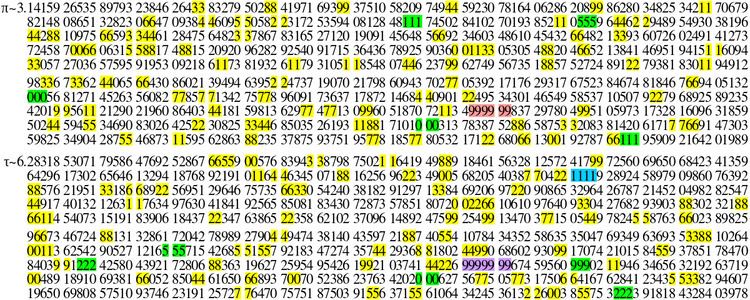 | ||
A sequence of six 9s occurs in the decimal representation of π, starting at the 762nd decimal place. It has become famous because of the mathematical coincidence and because of the idea that one could memorize the digits of π up to that point, recite them and end with "nine nine nine nine nine nine and so on", which seems to suggest that π is rational. The earliest known mention of this idea occurs in Douglas Hofstadter's 1985 book Metamagical Themas, where Hofstadter states
Contents
I myself once learned 380 digits of π, when I was a crazy high-school kid. My never-attained ambition was to reach the spot, 762 digits out in the decimal expansion, where it goes "999999", so that I could recite it out loud, come to those six 9's, and then impishly say, "and so on!"
This sequence of six nines is sometimes called the "Feynman point", after physicist Richard Feynman, who has also been claimed to have stated this same idea in a lecture. It is not clear when, or even if, Feynman made such a statement, however; it is not mentioned in published biographies or in his autobiographies, and is unknown to his biographer, James Gleick.
Related statistics
π is conjectured to be, but not known to be, a normal number. For a randomly chosen normal number, the probability of a specific sequence of six digits occurring this early in the decimal representation is usually only about 0.08%. However, if the sequence can overlap itself (such as 123123 or 999999) then the probability is less. The probability of six 9s in a row this early is about 10% less, or 0.0686%. But the probability of a repetition of any digit six times starting in the first 762 digits is ten times greater, or 0.686%.
The early string of six 9s is also the first occurrence of four and five consecutive identical digits. The next appearance of four consecutive identical digits is of the digit 7 at position 1,589.
Other patterns are possible: a repetition of a digit three times in the first three digits, or four times starting in the first ten digits, or five times in the first 100 digits, and so on. Each of these has about a 1% chance. So looking at repeats up to length 12, there is about a 10% chance of finding something as surprising as the six nines. From this point of view, the fact that we really do find a repeat of several digits after 762 digits is not really very surprising.
The next sequence of six consecutive identical digits is again composed of 9s, starting at position 193,034. The next distinct sequence of six consecutive identical digits starts with the digit 8 at position 222,299, while strings of nine 9s next occur at position 590,331,982 and 640,787,382.
The positions of the first occurrences of 9, alone and in strings of 2, 3, 4, 5, 6, 7, 8, and 9 consecutive 9s, are 5; 44; 762; 762; 762; 762; 1,722,776; 36,356,642; and 564,665,206; respectively (sequence A048940 in the OEIS).
Decimal expansion
The first 1001 digits of π (1000 decimal digits), showing consecutive runs of three or more digits, including the consecutive six 9s underlined and coloured red, are as follows:
